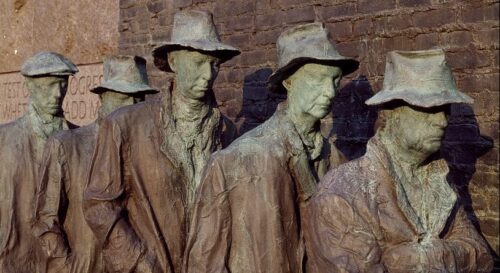
Great Depression and World War 2 Toolkit
Americans and the American system of government were faced with two existential challenges, overlapping, in the form of the Great Depression and the Second World War. The Great Depression, lasting more than a decade, created economic, social, and political challenges the country had never before experienced to such extents, and resulted in political and legal activity that had never before been considered. FDR’s expansion of the federal government was not only one of scope, but also reach, acting directly on individual Americans’ lives in ways it had never before. Adding to the challenges of the 1930s was the rise of expansionistic and belligerent dictatorships in Germany, Italy, and Japan, and the world war they caused.
Guiding Questions
- How did Hoover and FDR differ in their approaches to addressing the Great Depression?
- How did the federal government and its scope change as a result of Roosevelt’s New Deal?
-
What arguments did Roosevelt and Wheeler offer for or against aiding Great Britain in 1940-41?
- What was the United States fighting for in World War II?
Essential Documents
- Commonwealth Club Address, 1932, FDR
- Speech on the Consequences of the Proposed New Deal, 1932, Herbert Hoover
- First Inaugural Address, 1933 (excerpts), FDR
- Fireside Chat on the New Deal, 1933, FDR
- Fireside Chat on the Plan for Reorganization of the Judiciary, 1937, FDR
- Radio Address, 1940, Senator Burton Wheeler
- The Four Freedoms, 1941, FDR
- Pearl Harbor Speech, 1941, FDR
- D-Day Message, 1944, Dwight D. Eisenhower
- The Yalta Conference, 1945
Resources
Webinars
- Special Webinar: D-Day +76 Years and the Liberation of Europe
- American Minds: Douglas MacArthur
- American Presidents: FDR
- Documents in Detail: FDR’s 1944 State of the Union Speech
- Moment of Crisis: Attack on Pearl Harbor
- Documents in Detail: Hoover’s Speech on the New Deal
- Documents in Detail: FDR’s Commonwealth Club Address
- Great American Debates: FDR vs. Hoover in the Election of 1932
Lesson Plans
- The Road to Pearl Harbor: 1915-1941 – a four-lesson series that traces the roots of Japan’s decision to attack the United States in 1941
- From Neutrality to War – a multi-day examination of American isolationism after WW1, neutrality during the stormy decade of the 1930s, and eventually war
- American Diplomacy in WW2 – a four-day study of American foreign policy and diplomacy, with both enemies and allies, during the Second World War
- The United States in World War 2 – a four-lesson arc focused on the decisions and actions of the United States within the war itself
- The Allied Conference System, 1942-45 – a multi-day lesson focused on the Allied conferences held throughout the war, emphasizing their goals and long-term impact
- What’s so “new” about the New Deal? – A short set of lessons intended to help introduce students to the basics of FDR’s New Deal, as well as why these programs were controversial at the time and since
